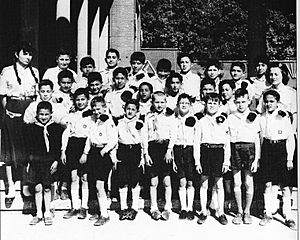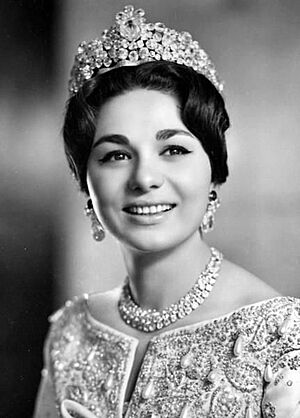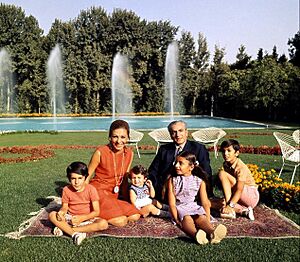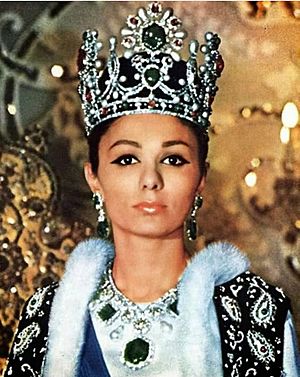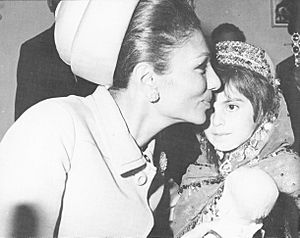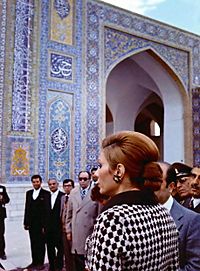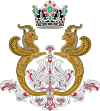Farah Pahlavi facts for kids
Quick facts for kids Farah Pahlaviفرح پهلوی |
|
|---|---|
| Shahbânu | |
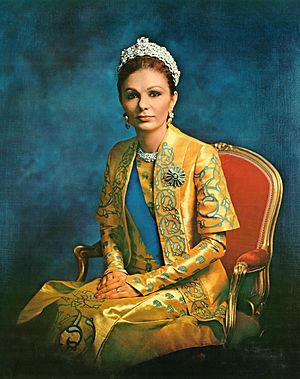
Official portrait, c. 1973
|
|
| Queen/empress consort of Iran | |
| Tenure | 21 December 1959 – 11 February 1979 |
| Coronation | 26 October 1967 |
| Born | Farah Diba 14 October 1938 Tehran, Imperial State of Iran |
| Spouse | |
| Issue |
|
| House | Pahlavi (by marriage) |
| Father | Sohrab Diba |
| Mother | Farideh Ghotbi |
| Signature |  Persian signature Latin signature |
Farah Pahlavi (born 14 October 1938) was the last Empress of Iran. She was the third wife and widow of Mohammad Reza Pahlavi, who was the last Shah (King) of Iran.
Farah was born into a well-off family in Iran. However, her family faced financial difficulties after her father passed away when she was young. She later studied architecture in Paris, France. There, she met the Shah at the Iranian embassy. They got married in December 1959. The Shah's previous marriages had not resulted in a son, which was important for the royal family to continue. So, everyone was very happy when their son, Crown Prince Reza, was born in October 1960.
As Empress, Farah worked hard to improve life for people in Iran. She started charities and helped create Shiraz University, which was the first American-style university in Iran. This helped more women go to college. She also helped bring ancient Iranian treasures back to museums in Iran from other countries.
By 1978, there was growing unrest and protests against the government in Iran. This led to the Iranian Revolution. In January 1979, Farah and the Shah had to leave the country because their lives were in danger. Many countries were afraid to let them in, but Anwar Sadat's Egypt welcomed them. The Shah was very ill and passed away in July 1980 while in exile. Farah has continued her charity work and now lives between Washington, D.C., and Paris.
Contents
Farah's Early Life
Farah Diba was born on October 14, 1938, in Tehran, the capital of Iran. She came from a wealthy family. She was the only child of Captain Sohrab Diba, who was an officer in the Iranian army and had studied at a military school in France. Her mother was Farideh Ghotbi.
In her book, Farah shared that her father's family came from Iranian Azerbaijan. Her mother's family was from Lahijan, a city near the Caspian Sea. Her grandfather had been a diplomat, working as the Persian Ambassador in Russia in the late 1800s.
Farah felt very close to her father. His death in 1948, when she was only 10, affected her deeply. After his death, her family faced financial struggles. They had to move from their large family home in northern Tehran to share an apartment with one of her mother's brothers.
Education and Meeting the Shah
Farah Diba started her schooling at the Italian School in Tehran. She then went to the French Jeanne d’Arc School and later to the Lycée Razi. She was a good athlete and was even the captain of her school's basketball team. After high school, she went to Paris to study architecture at the École Spéciale d'Architecture.
Many Iranian students studying abroad received support from the government. So, when the Shah visited other countries, he often met with Iranian students there. It was during one of these meetings in 1959, at the Iranian Embassy in Paris, that Farah Diba first met Mohammed Reza Pahlavi.
After Farah returned to Tehran in the summer of 1959, she and Mohammad Reza began spending time together. They announced their engagement on November 23, 1959.
Marriage and Family Life
Farah Diba married Shah Mohammed Reza on December 20, 1959. She was 21 years old. Her wedding was a big event that received attention from all over the world. Her wedding dress was designed by Yves Saint Laurent. She also wore a special crown called the Noor-ol-Ain Diamond tiara.
After the wedding, the most important thing was for Farah to have a son. The Shah had been married twice before, but he only had a daughter. According to the rules of royal succession at the time, a daughter could not inherit the throne. There was a lot of pressure on Farah to have a male heir. The Shah and his government were very anxious about this. It was also known that the Shah's previous marriage ended because his wife could not have children.
Farah and the Shah had four children:
- Crown Prince Reza Pahlavi of Iran (born 31 October 1960). He and his wife Yasmine have three daughters:
- Princess Noor Pahlavi (born 3 April 1992)
- Princess Iman Pahlavi (born 12 September 1993)
- Princess Farah Pahlavi (born 17 January 2004)
- Princess Farahnaz Pahlavi of Iran (born 12 March 1963)
- Prince Ali Reza Pahlavi of Iran (28 April 1966 – 4 January 2011). He and his companion Raha Didevar had one daughter:
- Iryana Leila Pahlavi (born 26 July 2011)
- Princess Leila Pahlavi of Iran (27 March 1970 – 10 June 2001)
Empress Farah's Role
At first, Farah's main job as Queen was to have a male heir. After her son, the Crown Prince, was born, she was able to focus on other important activities.

Like many royal wives, Farah started with a mostly ceremonial role. In 1961, during a visit to France, she became friends with the French culture minister. This led to an exchange of art and cultural items between French and Iranian museums. She also attended openings of schools and hospitals. Over time, she became more involved in government matters, especially those related to women's rights and cultural development. She used her influence with the Shah to get funding and attention for these causes. Farah focused on "education, health, culture, and social matters," staying out of politics.
One of Farah's biggest projects was founding Pahlavi University (now Shiraz University). This university was designed to be like American universities, which was new for Iran. It aimed to improve education for Iranian women.
Farah worked long hours on her charity activities, often from 9 AM to 9 PM on weekdays. Eventually, she had a team of 40 people helping her with various requests for help. She became one of the most visible figures in the government and supported 24 different organizations for education, health, and culture. Her work for people made her very popular, especially in the early 1970s. During this time, she traveled a lot within Iran, visiting remote areas and meeting with local people.
Farah's importance was clear during the 1967 Coronation Ceremonies. She was crowned as the first shahbanu (empress) of modern Iran. Her role was further confirmed when the Shah named her as the official regent. This meant that if he died or became unable to rule before the Crown Prince turned 21, Farah would rule in his place. Naming a woman as regent was very unusual for a monarchy in the Middle East or a Muslim country.
Supporting Art and Culture
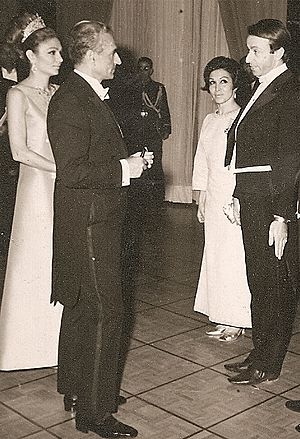
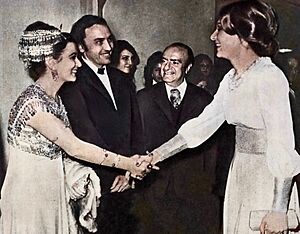
From the start of her royal life, Farah was very interested in promoting culture and arts in Iran. She helped create many organizations to bring Iranian art, both old and new, to attention in Iran and around the world.
Farah supported many types of art, including traditional Iranian arts like weaving and poetry, as well as Western theater. One of her most famous efforts was supporting the Shiraz Arts Festival. This festival took place every year from 1967 to 1977 and featured live performances by artists from Iran and other countries.
Most of her time was spent creating museums and building their collections. As an architecture student, Farah loved architecture. The Royal Palace of Niavaran, finished in 1968, shows her appreciation. It mixes traditional Iranian design with modern 1960s styles. Her personal library there has 22,000 books, mostly about art, philosophy, and religion.
Collecting Ancient Art
Iran has a rich cultural history, but in the 1960s, many of its ancient art treasures were in museums and private collections outside the country. One of Farah's main goals was to bring these historic artifacts back to Iran. She got permission and money from the government to buy back many Iranian artifacts from foreign and local collections. With these items, she founded several national museums that still exist today.
Museums and cultural centers created under her guidance include the Negarestan Cultural Center, the Reza Abbasi Museum, the Khorramabad Museum, the National Carpet Gallery, and the Glassware and Ceramic Museum of Iran.
Collecting Modern Art
Besides ancient Iranian art, Farah was also interested in buying modern Western and Iranian art. She strongly supported the Tehran Museum of Contemporary Art.
Using government funds, the Empress took advantage of a time in the 1970s when art prices were lower. She bought about 150 important works by famous artists like Pablo Picasso, Claude Monet, Andy Warhol, and Jackson Pollock. The collection at the Tehran Museum of Contemporary Art is considered one of the most important outside Europe and the United States. Its value is estimated to be billions of dollars.
After the Islamic Revolution in 1979, the new government was against Western influence. However, they kept Farah's Western art collection, likely because of its huge value. For almost 20 years, it was stored away and not shown to the public. This changed in September 2005, when a large part of the collection was briefly displayed in Tehran.
The Iranian Revolution

By early 1978, many people in Iran were unhappy with the government. By the end of the year, citizens were protesting against the monarchy. Farah wrote in her book that there was a "growing sense of unease." Because of safety concerns, most of the Empress's official activities were canceled.
Riots and unrest became more frequent. In January 1979, the government declared martial law in most major cities, and the country was on the edge of a full revolution. Mohammad Reza and Farah left Iran by plane on January 16, 1979.
Life After Leaving Iran
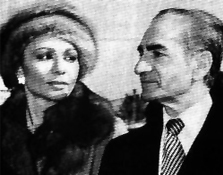
For over a year, Farah and the Shah looked for a permanent place to live. Many governments were unwilling to let them in. This was because the new government in Iran had ordered their arrest and death, and it was unclear how much pressure Iran would put on other countries.
Egyptian president Anwar Sadat, who had been friends with Mohammad Reza for years, allowed them to stay in Egypt. They also spent time in Morocco as guests of King Hassan II, and in the Bahamas. When their visas for the Bahamas were not renewed, they went to Mexico and rented a house near Mexico City in the summer of 1979.
The Shah's Illness
After leaving Egypt, Mohammad Reza's health got worse. He had a type of cancer called non-Hodgkin's lymphoma. In October 1979, the couple was allowed into the United States for medical treatment. This made relations between the U.S. government and the revolutionaries in Tehran even more tense. These tensions eventually led to the attack on the American embassy in Tehran, known as the Iran hostage crisis.
The Shah and Empress were not allowed to stay in the United States. Shortly after the Shah's surgery on October 22, 1979, they left for Contadora Island in Panama. Both Mohammad Reza and Farah felt that the U.S. government at the time had not supported them enough.
There were rumors that the Panamanian government might arrest Mohammad Reza to send him back to Iran. The Shah and Empress asked President Anwar Sadat if they could return to Egypt. Their request was granted, and they went back to Egypt in March 1980. They stayed there until the Shah's death four months later, on July 27, 1980.
Life in Exile
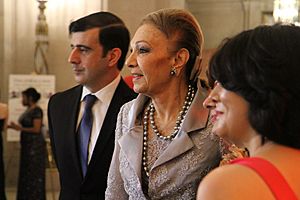

After the Shah's death, Farah lived in Egypt for two years. President Anwar Sadat allowed her and her children to stay in the Koubbeh Palace. For a short time, from July 27 to October 31, 1980, she was the regent in name. A few months after President Sadat's death in October 1981, Farah and her family left Egypt. President Ronald Reagan told her she was welcome in the United States.
Farah first settled in Massachusetts, then bought a home in Connecticut. After her daughter Princess Leila passed away in 2001, Farah bought a smaller home in Maryland, near Washington, D.C., to be closer to her son and grandchildren. Farah now divides her time between Washington, D.C., and Paris. She visits Mohammad Reza Shah's burial place in Cairo every July.
In various TV interviews, Farah Pahlavi has spoken about her time as Empress, the Shah, her children, the Iranian Revolution, and her life in exile. She has also talked about her own mistakes and misjudgments.
Farah attended the funeral of former U.S. president Ronald Reagan in 2004. She supports charities, including a gala in Paris for Alzheimer's disease research.
Farah continues to attend international royal events. These include the 2004 wedding of Crown Prince Frederik of Denmark, the 2010 wedding of Prince Nikolaos of Greece and Denmark, the 2011 wedding of Albert II, Prince of Monaco, the 2016 wedding of Prince Leka of Albania, the 2023 funeral of Constantine II of Greece, and the 2023 wedding of Crown Prince Hussein of Jordan.
Her Memoir
In 2003, Farah wrote a book about her marriage to Mohammad Reza called An Enduring Love: My Life with the Shah. This book gained international attention. It was a best-seller in Europe, and parts of it appeared in magazines. Farah also appeared on talk shows. The book received mixed reviews. Some called it "a candid, straightforward account," while others described it as "full of anger and bitterness." However, an Iranian writer praised it for showing "affection and sympathy for her countrymen."
Documentaries and Plays
In 2009, a director named Nahid Persson Sarvestani released a documentary film about Farah Pahlavi's life called The Queen and I. The film was shown at several international film festivals. In 2012, a Dutch director created a theater play inspired by Farah Pahlavi's life in exile.
Honours and Awards
| Styles of Empress Farah of Iran |
|
|---|---|
| Reference style | Her Imperial Majesty |
| Spoken style | Your Imperial Majesty |
Farah Pahlavi has received many honors and awards from Iran and other countries for her work and royal status.
From Iran
- Member 1st Class of the Order of the Pleiades
From Other Countries
 Austria: Grand Star of the Decoration of Honour for Services to the Republic of Austria
Austria: Grand Star of the Decoration of Honour for Services to the Republic of Austria Czechoslovakia: Grand Cross of the Order of the White Lion
Czechoslovakia: Grand Cross of the Order of the White Lion Denmark: Order of the Elephant
Denmark: Order of the Elephant Italy: Grand Cross with Collar of the Order of Merit of the Italian Republic
Italy: Grand Cross with Collar of the Order of Merit of the Italian Republic Norway: Grand Cross of the Order of Saint Olav
Norway: Grand Cross of the Order of Saint Olav Spain: Grand Cross of the Order of Isabella the Catholic
Spain: Grand Cross of the Order of Isabella the Catholic Thailand: Dame of the Most Illustrious Order of the Royal House of Chakri
Thailand: Dame of the Most Illustrious Order of the Royal House of Chakri
Special Awards
 Austria: Look! Women of the Year Hope Award
Austria: Look! Women of the Year Hope Award France: Foreign Associate Academician of the Académie des Beaux-Arts
France: Foreign Associate Academician of the Académie des Beaux-Arts Germany: Steiger Award
Germany: Steiger Award Germany: Südwestfalen Charlie Award
Germany: Südwestfalen Charlie Award United States: National Museum of Women in the Arts Award for International Cultural Patronage
United States: National Museum of Women in the Arts Award for International Cultural Patronage
See also
 In Spanish: Farah Pahlaví para niños
In Spanish: Farah Pahlaví para niños
- Empress's Crown


